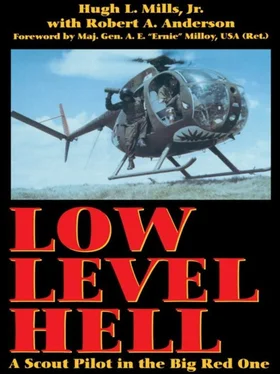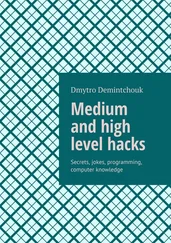To further refresh my memory, and to maintain as high a degree of accuracy as possible, I have referred to numerous printed works, primarily operational and casualty reports of the units concerned.
In September 1971, I would return to Vietnam as a Cobra pilot for C Troop, 3d Squadron, 5th Cavalry working from Quang Tri airfield in I Corps, ranging from the A Shau Valley to the string of fire bases along the DMZ. When the unit deployed to the United States in February 1972, I elected to remain in-country and look for another cav troop. I was a single captain and intended to make the service my career. I was ultimately assigned to C Troop, 16th Cavalry operating out of Can Tho in the IV Corps tactical area. To my surprise this was again Darkhorse. The troop had remained in country in 1971 when the Big Red One went home to Fort Riley, Kansas, and had been redesignated as an independent troop of the 164th Combat Aviation Group.
My new position was aeroscout platoon leader—Darkhorse One Six—and asleep on my new bunk on the day I arrived was my new wingman, Captain Rod Willis.
Hugh L. Mills, Jr. LTC, Aviation, U.S. Army
* * *
Shortly after his first tour in Vietnam, Hugh Mills jotted down the following thought: “Many volumes have been and will be written on the Vietnam conflict, for Vietnam was the environment in which doctrine for the employment of the helicopter in airmobile and air cavalry operations was written. This doctrine was written not by the major commanders in the Pentagon, but by the young officers and enlisted men in their daily struggle to complete the mission of combat.”
As one of the army helicopter scout pilots who helped significantly in the writing of that doctrine, Hugh Mills flew over 2,000 combat hours in Vietnam, most of them logged in his near idolized OH-6A Loaches. He believed that going to Vietnam was just another chapter in his army career. But while he was there, he was going to carry the point of the bayonet to the enemy’s throat every way he could, every time he could. Not for the glory, but in the honest hope that U.S. servicemen and women could soon go home victorious, and that the people of Vietnam could, after being ravaged by war for so long, reclaim their country and live in peace.
Though it is not in Hugh Mills’s disposition to speak of the honors that came to him flying scouts in Vietnam, one simply can’t overlook the fact that Lieutenant Colonel Mills completed his service in Southeast Asia by being awarded: three Silver Stars, four Distinguished Flying Crosses, two Bronze Stars for Service, one Bronze Star for Valor, three Purple Hearts, seventy-two Air Medals (six with V for valor), three Army Commendation Medals (all with V device), one Vietnam Service Medal, one Republic of Vietnam Campaign Medal (six battle stars). And from the Republic of Vietnam government: Republic of Vietnam Cross of Gallantry (with Silver Star and Palm), Republic of Vietnam Technical Service Honor Medal First Class, and Republic of Vietnam Civic Action Medal First Class.
There’s another thing about Hugh Mills that can’t be overlooked, and that’s the pride he takes in his own work, and in all those who worked with him in Vietnam. The men of D Troop (Air), and especially the aeroscouts of the Big Red One’s Outcasts platoon, hold to this day a very special place in Hugh Mills’s heart. In Vietnam, the life of a Loach crewman was only as good as the other guy in the ship. They depended upon each other to stay alive—there was probably no closer military comradery than that between the aeroscout crew chief and his pilot.
Mills, in my observation, has never lost the spirit of that comradery even though his tours in Vietnam ended some 22 years ago. He still tracks those who survived and made it back home, and takes pride in knowing the whereabouts of his fellow Darkhorsemen:
Tom ChambersA corporate pilot now living in Texas.
Bob DavisRetired from the army as a CW-4, now a corporate pilot living in Ohio.
Al FarrarNow lives and teaches school in his home state of Rhode Island.
Jon GregoryRetired from the army, currently a civilian airplane pilot for the U.S. Army.
Stu HarrellNow lives in Arizona and works as an investment planner.
Bob HarrisWent to flight school after his Vietnam tours, became a pilot, and now serves in the army in Texas as a lieutenant colonel.
BillHayes Now works as a police officer in Washington, D.C.
John HerchertLives and works as a sales representative in Missouri.
Bob HolmesRetired from the army, now an airline pilot.
Larry KauffmanLives in Texas and is a regional sales manager.
Chuck KorandaCurrently serving as a CW-4 in the Wisconsin Army National Guard.
Tim McDivittNow lives in Florida where he is in business.
Major Charles MooreLives in Tennessee where he is a county executive.
Jim ParkerLives in Georgia where he is a factory supervisor.
Dean SinorLives in Kentucky where he is a corporate helicopter pilot.
Ken StormerCurrently living in Texas where he is a rancher.
Doug VeitchRetired from the army, now an investment planner in Colorado.
Rod WillisRetired from the army as a lieutenant colonel, now a consultant for army programs in Kansas.
Mike WoodsRetired from the army, now a plant manager in California.
My association with Hugh Mills began in August 1986, when Low Level Hell went from an abstract idea to a tangible effort. My work with him over these past five years has been a rich, fulfilling, and thoroughly enjoyable experience. I marvel at his vivid recall of those Vietnam days, at his sly sense of humor, at his heartfelt anguish in recounting the loss or injury of one of his fellow Outcasts.
My days of military service are long since behind me, and I still look forward to the day when sound political judgments can eliminate wars. But until then, I can only hope that our country continues to generate and be blessed with people like Hugh Mills, a man with whom I heartily agree when he appraises Vietnam’s controversial aftermath by urging, “Blame the war, not the warrior!”
Robert A. Anderson
ACAV—armored cavalry assault vehicle
AK-47—Russian 7.62-caliber assault rifle
APC—armored personnel carrier M113
Arc Light—B-52 bomb strike
ARP—aerorifle platoon
ARVN—Army of the Republic of Vietnam
BDA—bomb damage assessment
C and C—command and control
CAR-15-—carbine version of M-16 automatic rifle
Charlie Echo—crew chief
chicken plate—ballistic armor chest plate worn by aerial crew members
CH1COM—Chinese Communist
Claymore—antipersonnel mine, directional in nature
Cobra (snake)—Bell AH-IG helicopter gunship with two crew members
CS grenade—riot control agent similar to tear gas
DEROS—date estimated to return from overseas
didi—Vietnamese slang for get out of here
Dustoff—callsign of medical evacuation helicopters
FAC—forward air controller, prop aircraft for tac air direction
fast mover—jet fighter or bomber
Firefly—UH-IH mounted with spotlights, night observation devices, miniguns, and a .50-caliber machine gun
Читать дальше












